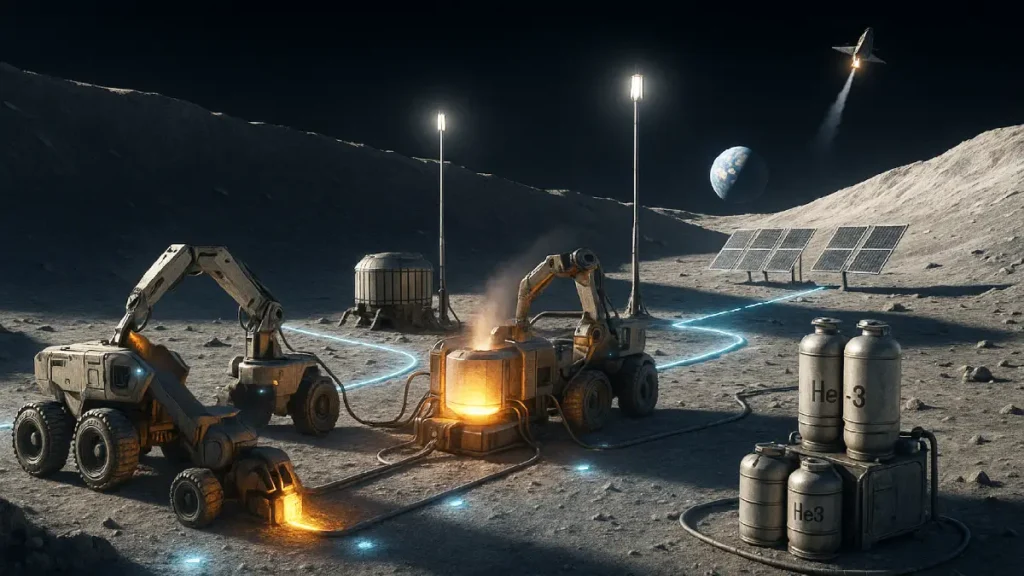Helium-3 has a mythic price tag—about 19 million dollars per kilogram—and an even bigger narrative: a clean-fusion future powered by the Moon. Yet the true contest between the US and China isn’t simply about scooping isotopes from regolith. It’s a systems race: who can stand up the infrastructure, legal cover, customers, and industrial capabilities to make lunar extraction commercially and strategically meaningful. Seen this way, helium-3 is the tip of a spear aimed at rewiring energy, compute, and space power projection in the late 2020s and 2030s.

The resource: what helium-3 is—and isn’t
Helium-3 is a light, non-radioactive isotope prized for two near-term and one long-term application: ultra-low-temperature cooling for quantum computing, niche scientific instrumentation, and potential aneutronic fusion fuels if reactor concepts mature. On Earth it’s vanishingly scarce; on the Moon, solar wind has implanted trace amounts into the top layer of regolith over billions of years. The catch is concentration: even the “rich” patches are lean ore, meaning any serious supply requires high-throughput excavation, heating, and gas capture. It’s more like strip-mining powder than picking nuggets—industrial scale or bust.
The enabling stack: what it takes to mine a gas from dust
To turn helium-3 from idea to inventory requires an interlocking stack of capabilities:
- Prospecting and mapping: orbital sensing, in-situ assays, and machine-vision-guided rovers to target regolith with the highest helium-3 and volatiles content.
- Thermal extraction at scale: regolith must be heated to several hundred degrees Celsius to release trapped volatiles; kilns or conveyor roasters need to process millions of tons over time, favoring modular, redundant systems.
- Power and thermal management: solar fields with energy storage or small fission units to sustain continuous operations across frigid nights and dusty days; waste heat recovery to improve extraction efficiency.
- Dust-hard robotics: autonomous mining fleets, abrasion-resistant joints, self-cleaning optics, and swappable modules to cope with glassy, electrostatically charged dust.
- ISRU logistics: on-site gas separation, compression, and safe storage of mixed volatiles; propellant production from polar ice to refuel return stages.
- Return-to-Earth transport: standardized, low-mass pressure vessels and ascenders that rendezvous with a tug in lunar orbit for shipment home, minimizing delta-v costs.
The pattern is clear: every subsystem amplifies—or constrains—the others. Without robust power, extraction stalls. Without dust-tolerant autonomy, maintenance kills uptime. Without propellant from lunar ice, transport economics break. Helium-3 forces a whole-economy build-out.
The players: US vs. China and the role of private capital
- China’s state-led model: Sample returns, far-side operations, and plans for a permanent base signal an integrated national strategy that bundles science, prestige, and resource positioning. The approach concentrates risk but accelerates infrastructure coherence—landing pads, power systems, teleoperations, and heavy-lift cadence can be aligned to strategic timelines.
- The US ecosystem: A modular coalition of government programs, defense-adjacent logistics, and venture-backed firms pursuing helium-3 harvesters, regolith handling, and lunar transport. Advantages include rapid iteration, diversified bets, and market pull from quantum, medical, and research sectors already buying helium-3 at high prices. Risks include coordination friction and funding cyclicality.
- Second-order actors: Europe, Japan, and India provide critical technologies and standards leadership. Meanwhile, insurers, commodity traders, and certification bodies will quietly determine bankability and offtake credibility.
The law: mining rights, safety zones, and “soft enclosure”
The Outer Space Treaty forbids sovereignty claims but allows resource utilization under national authorization and supervision. Expect “safety zones” around operational sites and navigation corridors to manage interference, creating de facto exclusive operating areas without explicit territorial claims. The real legal contest is standard-setting: telemetry disclosures, environmental stewardship of ejecta plumes and dust, and protocols for multi-operator traffic—rules that can tilt operating costs and development paths in favor of early shapers.
The economics: 19 million dollars per kilogram sounds rich—until the capex shows up
Helium-3’s headline price tempts bold claims, but cash flows depend on:
- Grade and throughput: Even modest annual output demands industrial-scale regolith handling, favoring teams that master high duty-cycle autonomy and maintenance-lite designs.
- Co-products: Water, oxygen, and other volatiles or metals can subsidize costs. Using extracted hydrogen and oxygen as on-site propellant slashes logistics costs and closes loops on power and life support.
- Demand timing: Near-term revenue likely comes from helium-3’s existing ultra-cold applications and government procurement, not fusion. Long-term upside hinges on fusion milestones and reactor designs that actually use helium-3.
- Launch and transport costs: Reusable heavy-lift and cislunar tugs compress the cost curve. Regular cadence can transform one-off missions into a supply chain, unlocking financing.
Why helium-3 is a strategic wedge, even without fusion
Even if aneutronic fusion slips decades, the race still pays off by catalyzing:
- Lunar industrialization: Power, excavation, and ISRU networks that later pivot to oxygen, metals, and construction materials for habitats and telescopes.
- Energy independence optics: The nation fielding a credible lunar resource supply chain gains signaling power in energy security and dual-use tech leadership.
- Quantum and research superiority: Guaranteed helium-3 supply underwrites sensitive cryogenics for quantum computing and detectors—small volumes, high strategic leverage.
- Norms leadership: First movers write the practical rulebook for traffic, safety zones, and environmental baselines that others must follow.
Bottlenecks to watch—and how each side might solve them
- Robotic reliability in lunar dust: Closed-joint actuators, conformal coatings, magnetic dust traps, and redundancy via swarms rather than single massive machines.
- Continuous power across lunar night: Hybrid architectures—solar plus long-duration batteries, regenerative fuel cells, or compact fission. Centralized planning could fast-track fission units; a diversified commercial ecosystem may pilot multiple microreactor and storage approaches.
- Thermal processing efficiency: Moving-bed or fluidized-bed kilns with heat recuperation; localized thermal domes that bake regolith in situ; microwave sintering trials to reduce moving parts.
- Precision prospecting: Coordinated orbital sensing and on-site validation; models trained on returned samples to refine target selection and minimize dead dig.
- Return logistics: Standardized gas canisters, isochore packaging for cryogenics, and small reusable ascenders that rendezvous with a cislunar depot—think parcel service, not bespoke missions.
What “winning” actually looks like by the early 2030s
- Regular sample-return cadence for industrial, not purely scientific, purposes.
- A handful of semi-autonomous extraction pilots operating near permanently lit ridges or polar resource hubs, each producing kilograms-per-year helium-3 and larger volumes of oxygen and water.
- Government-backed offtake contracts guaranteeing minimal purchase volumes to de-risk capital expenditure.
- Interoperable lunar standards: landing pads, power connectors, interface specs for rovers and canisters.
- Insurance and commodity contracts emerging for lunar volatiles, with price discovery tied to delivered-in-cislunar-orbit terms.
A measured contrarian note
The helium-3 narrative can overpromise. Fusion timelines are uncertain, lunar mining will be costly and complex, and other terrestrial fusion fuel cycles may outcompete on cost. Yet as a strategic forcing function, helium-3 compels the build-out of exactly the capabilities needed for a durable lunar economy. Even if the end market pivots, the same machinery can make oxygen, metals, and propellant. In that sense, helium-3 is the story that funds the scaffolding for everything else.
Practical implications for leaders
- Treat helium-3 as a catalyst project: prioritize dual-use subsystems—dust-proof robotics, thermal processing, and cislunar logistics—that pay off across lunar industries.
- Secure early offtake and standards positions: they shape capital flows more than raw science breakthroughs.
- Invest in co-location: power, ISRU, and communications hubs near resource-rich zones become gravity wells for industry.
- De-risk with simulation twins and Earth analog test ranges: iterate fast on autonomy, wear, and thermal cycles before committing mass to the Moon.




